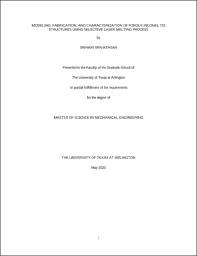| dc.description.abstract | Bio-inspired cellular structures are of great interest these days for many applications, from engineering research to industries. Honeycomb, Body-Centered Cubic with/without Z-struts (BCC-Z/ BCC), Face Centered Cubic with/without Z-struts (FCC-Z/ FCC), and Triply Periodic Minimal Surface (TPMS) such as Gyroid, Diamond, and Schwartz lattices are the most common bio-inspired lattice structures. These structures can be tailored based on their structural organization resulting in superior materials with lightweight properties, adequate strength, and low stiffness. Thankfully, additive manufacturing (AM) has made the fabrication of these complex cellular materials realistic. However, the use of AM could lead to several defects, such as damaged cell walls, irregular thickness, flawed joints, partially missing layers, and improper elastic/plastic behavior. The critical aspect is to try and reduce the manufacturing defects that can help evaluate the overall performance of lattice structures. The primary goal is to discover the characteristics of each morphology type, pore size, porosity percentage by assessing their fabrication quality, microstructure, and mechanical behavior. To these ends, cellular structures of different volume fraction, pore shape, and unit cell size are designed and manufactured using selective laser melting (SLM), the most common AM process. The produced samples are characterized through optical microscopy, scanning electron microscopy (SEM), and x-ray powder diffraction (XRD). Finally, a comprehensive report on optimal porosity design is provided after studying the fundamental parameters from the design, fabrication, and testing phases. The knowledge obtained in this research will enable the production of lightweight metallic devices with custom spatially designed properties by additive manufacturing | |


